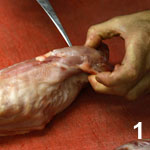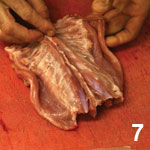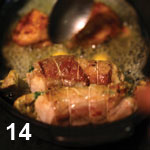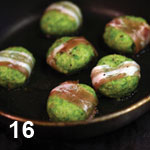Rabbit – a masterclass
Often underused on menus in the UK, rabbit is rated as highly as veal on the Continent thanks to its pink and tender meat. Few can cook it quite like the Capital's Eric Chavot, who shares his love for it here. Michael Raffael reports
Think of rabbit as food and often some unflattering associations come to mind: myxomatosis striking miners snaring rabbits to feed starving children Mr McGregor's rabbit pie cuddly, fluffy pet bunnies. Attempts by UK supermarkets to persuade consumers to purchase Chinese or Australian imports have flailed and floundered.
On the Continent there's a different attitude. At any country market across the Channel domestic rabbit reared for the table is for sale: it's an artisanal cottage industry. The pink, tender meat rates as highly as veal. Italy is the largest annual consumer in the EC, at about 5.5kg per person. In Spain, rabbit, not chicken, is an essential ingredient of the classic paella recipe.
At the Capital hotel in Knightsbridge, London, Eric Chavot pays as much for his farmed rabbit as he does for free-range chicken or duck. France has several Label Rouge producers and a newly introduced breed, the Rex de Poitou, that is mentioned by name on restaurant menus. Italy has its own Marchio di Qualita (quality mark).
Rabbits are reared in confinement - not the gross overcrowding associated with the industrial poultry industry, but not free-range either. Large farms will expect to rear the animals to slaughter in 90 days, but artisanal husbandry allows for slower growth, typically five months.
Rabbit carcasses should weigh 1,500-1,700g, drawn weight, head on, with the liver and kidneys in place. They will yield a slightly higher percentage of usable meat than chicken.
Quality points include: bright eye firm, pink, dense flesh with a shiny aspect short, plump legs no dryness no stickiness. The kidneys should be covered in white fat, and the liver should be reddish and moist with no browning at the edges. Domestic rabbits don't smell musty or gamey.
Eric Chavot
Eric Chavot can list Marco Pierre White, Nico Ladenis and Raymond Blanc on his CV, but his deepest allegiance is to Pierre Koffmann, for whom he worked as a sous chef in the early 1990s.
Although Chavot's two-Michelin-starred restaurant cooking is refined (Condé Nast Traveller voted the Capital the best hotel restaurant for food in 2006), it remains anchored in the practices of classic French traditions.
Still a hands-on chef, his brigade watches his every move - as Chavot watches them. He cooks now with the same authority as Koffmann, the taste of what's on the plate always mattering most.
• Eric Chavot offers quarterly master classes at the Capital (www.capitalhotel.co.uk).
Loin and brochette of rabbit, pea patties with ventrêche, onion soubise and lettuce chiffonnade
Rabbit
Weight: 1,700g
Cost price: £11
Loin portions: 4
Leg portions: 2
Other: Shoulders confit for a pressed terrine trimming for a jus
BUTCHERY
Prime joints Start from the head and work back down the body to the tail. Cut off the head and set it aside with the other trimmings.
Neck, shoulders and trimmings Pull a foreleg away from the carcass. Cut around it, following the natural conformation (1). Sever the ligament attaching the end of the bone to the socket into which it slots (2). Repeat with the second foreleg.
Turn the carcass on to its back to expose the ribcage. Mark lines between the fourth and fifth ribs. Separate the neck end from the hindquarter at this point by cutting through the backbone. Split the neck end into two by cutting out the backbone with poultry shears.
Legs Following their natural conformation, remove the hind legs in the same way as the forelegs (3, 4).
Variations
To tunnel bone a thigh bone, scrape around it with the blade of a sharp filleting knife as far as the knee joint (5). Twist it until it breaks free. Turn the thigh meat inside out, exposing the joint. Cut it out carefully without puncturing the flesh.
The meat is covered with a shiny silverskin. For the rabbit brochette (see below), separate the thigh from the bone-in shin. Use a flexible-bladed knife edge to remove the silverskin, then cut the thigh muscle into pieces weighing about 20g each.
Loin Turn the carcass on its back. Remove the kidneys and split them in half. Remove the liver (6) and cut it into four. Remove the two strips of fillet.
Following the line where the legs joined the back, cut through the backbone.
To bone out the loins: keeping the carcass on its back, scrape along the ribs, exposing them, and work them free one at a time (7). Cut out the small piece of cartilage to which each one is attached (8).
Turn the carcass over and, following the line of the backbone, remove the loins with the flanks attached (9).
Note the backbone has a double ridge on either side around which the blade must travel.
Stuffed loin
To stuff a loin, lay it on the work surface, forming a rectangle. The flank is made up of two distinct layers of meat. Using a very sharp knife, prise them apart (without detaching them) so that the area of flank is almost doubled. It will be used to envelope the stuffing.
Put a rabbit fillet beside the loin (10). Blanch a large Cos lettuce leaf in boiling water. Drain it on absorbent paper and roll it flat. Trim the edges to the same shape as the flank attached to the rabbit loin (11). Lay it on top. Place a tube of steamed morel and sweetbread stuffing on the leaf next to the loin. Roll up the flank around the stuffing and loin.
Fasten with kitchen string (12). Cut each loin into two pieces (13). Wrap in cooking film and reserve for service.
Optional If the loin is also wrapped in caul fat before being put in the film, the stuffing will not leak during cooking.
MOREL STUFFING
Eric Chavot uses a stuffing similar to Pierre Koffmann's morel and sweetbread farce for his classic stuffed pig's trotter.
Ingredients
300g chicken mousse
60-80g morels, chopped small
300g cooked calves' sweetbreads in small pieces
Method
Combine the ingredients. Use a piping bag with a large plain tube to pipe the stuffing in strips on to cooking film. Wrap up to form cylinders roughly 20cm long. Steam until just set.
LOIN AND BROCHETTE OF RABBIT, PEA PATTIES WITH VENTRECHE, ONION SOUBISE AND LETTUCE CHIFFONNADE
Ingredients
(Serves one)
1 wrapped portion stuffed rabbit loin
3tbs shredded iceberg lettuce
10ml water
80g butter
1 rabbit brochette (pieces of leg, liver and kidney)
Salt and pepper
About 60ml rabbit jus
3 pea and ventrÁªche patties
1tbs hot soubise
About 20g hot morel and sweetbread stuffing
Method
Steam the rabbit loin for five minutes. Wilt the lettuce chiffonade. Drain on absorbent paper. Boil the water and whisk in 40g butter to form an emulsion. Add the lettuce and keep hot (a larger amount of this emulsion is part of routine mise en place).
Brush a little butter on the brochette. Season and either roast five minutes in a hot oven or dry-fry. Rest.
Heat the rest of the butter until sizzling. Unwrap the steamed loin. Fry on all sides until caramelised (14). Season, remove from the pan, cut string and keep hot. Discard fat in the pan. Deglaze with rabbit jus and reduce to about two tablespoons. Fry the patties about 30 seconds on each side (16).
Spoon the lettuce into the centre of the plate and arrange. Cut the loin into three noisettes and arrange on the lettuce. On one side of the plate arrange a line of pea patties. On the other spoon a little soubise, a slice of stuffing and the brochette. Finish with a touch of rabbit jus.
RABBIT JUS
Ingredients
70ml oil
1kg rabbit bones and trimmings, chopped small
100g shallots, chopped
100g mushrooms chopped
2 garlic cloves, crushed
650ml light chicken stock
350ml water
Fresh thyme to taste
Method
Heat 50ml oil in a large frying pan or sauteuse until very hot. Add the rabbit bones and sear until thoroughly caramelised. Transfer to a saucepan. Add the rest of the oil to the pan, then the shallots, mushrooms and garlic. Fry until coloured and transfer to the pan with the rabbit.
Strain off the fat in the frying pan. Deglaze the pan with some of the stock. Scrape any sediment off the bottom and add to the pan with the rabbit. Add the rest of the liquids. Boil, skim, and add the thyme. Reduce heat and simmer 45 minutes.
SOUBISE
Chop up onions and stew in duck fat over a very low flame until very soft but not coloured. Season and blend to a purée, adding crème fraÁ®che to taste.
PEA PATTIES WITH VENTRECHE
Boil fresh petits pois in salted water with a few lettuce leaves. Drain thoroughly. Blend to form a stiff purée. Shape into small rissoles (about 4cm in diameter) and wrap a little ventrÁªche or pancetta around each one (15).
At the Capital
- Stuffed leg of rabbit ProvenÁ§ale (main course of £29.50 three-course lunch menu)
- Loin of rabbit with a brochette of leg, liver and kidney (main course of £58 three-course menu)
WINES The Capital's sommelier, Audrey Clastre, recommended a famous Graves, ChÁ¢teau Pape-Clément, to accompany the loin, though her initial thought was a Gevrey-Chambertin, 2002 Coeur de Roy from Bernard Dugat-Py, a smooth cherry-red Pinot Noir that's quite spicy, not over-oaked, with dark fruit and a little more acid than other wines from this area (about £80).
Eric Chavot's rabbit dishes
- Roast leg of rabbit ProvenÁ§ale, stuffed with olives and sunâ€'dried tomatoes, with a honey, sherry vinegar, light soy and tomato purée glaze
- Loin of rabbit stuffed with black pudding wrapped in lettuce
- Rabbit persillade: shoulder and lean trimmings from the neck, sautéd like frogs' legs with butter, garlic and broadleaf parsley
- Rabbit terrine: shoulder and lean trimmings confit in duck fat and formed into a terrine with dried cranberries, pistachios, prunes in Armagnac and foie gras
Photography by Lisa Barber (www.lisabarber.co.uk)


























